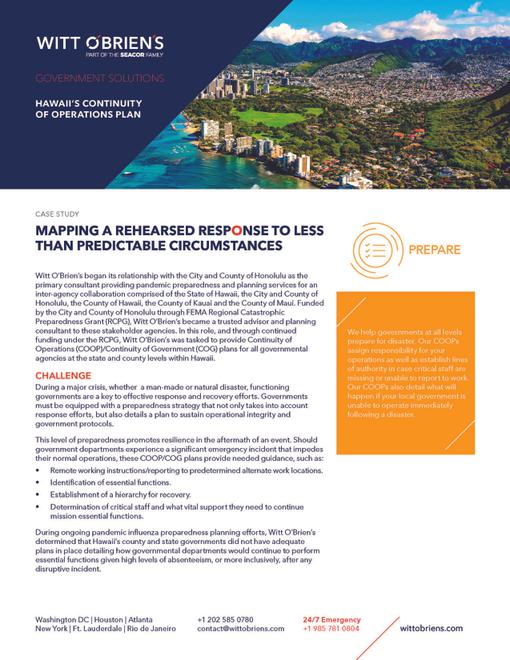MAPPING A REHEARSED RESPONSE TO LESS THAN PREDICTABLE CIRCUMSTANCES
Witt O’Brien’s began its relationship with the City and County of Honolulu as the primary consultant providing pandemic preparedness and planning services for an inter-agency collaboration comprised of the State of Hawaii, the City and County of Honolulu, the County of Hawaii, the County of Kauai and the County of Maui.
Funded by the City and County of Honolulu through FEMA Regional Catastrophic Preparedness Grant (RCPG), Witt O’Brien’s became a trusted advisor and planning consultant to these stakeholder agencies. In this role, and through continued funding under the RCPG, Witt O’Brien’s was tasked to provide Continuity of Operations (COOP)/Continuity of Government (COG) plans for all governmental agencies at the state and county levels within Hawaii.
CHALLENGE
During a major crisis, whether a man-made or natural disaster, functioning governments are a key to effective response and recovery efforts. Governments must be equipped with a preparedness strategy that not only takes into account response efforts, but also details a plan to sustain operational integrity and
government protocols.
This level of preparedness promotes resilience in the aftermath of an event. Should government departments experience a significant emergency incident that impedes their normal operations, these COOP/COG plans provide needed guidance, such as:
- Remote working instructions/reporting to predetermined alternate work locations
- Identification of essential functions
- Establishment of a hierarchy for recovery
- Determination of critical staff and what vital support they need to continue mission essential functions
During ongoing pandemic influenza preparedness planning efforts, Witt O’Brien’s determined that Hawaii’s county and state governments did not have adequate plans in place detailing how governmental departments would continue to perform essential functions given high levels of absenteeism, or more inclusively, after any
disruptive incident.
While many governmental agencies throughout Hawaii had made attempts to develop COOP plans in previous years, the level of planning did not comply with the expectations of the Department of Homeland Security (DHS), FEMA, and Federal Continuity Directive. Some COOP plans had been created to various degrees of completeness using a semi-decentralized approach, but the existing partial plans were not standardized and did not capture enough critical information to support the key and essential functions and services of the individual governmental departments.
The lack of and need for complete COOP/COG plans was recognized by the agencies involved. These agencies worked with Witt O’Brien’s to set a goal: create and develop a COOP plan for the identified departments
within each of the four counties and the state government. This level of plan development required an expert planning consultant with:
- Experience working with governments during crises.
- Understanding of the inner workings, processes and needs of government agencies.
- Detailed knowledge of federal COOP requirements.
Based on its proven background in crisis and emergency planning for governmental entities, as well as its active and established working relationships with all involved stakeholders through the pandemic planning project, Witt O’Brien’s was the selected firm to immediately fill the planning gap for COOP/COG.
SOLUTION
Witt O’Brien’s scheduled face-to-face meetings within each county and state department to train staff on the elements of COOP planning and collect pertinent data. Interview-style question and answer sessions then
took place to identify critical functions, assess the impact of interruptions and plan for needed resources. Information from these sessions was captured real-time within a DHS and FEMA compliant COOP template,
which when completed became the individual department’s COOP plan.
Furthermore, some large and complex state departments required division-level planning, along with a department-specific plan to consolidate resource prioritization strategies between the divisions.
These face-to-face meetings and interviews proved to be much more effective for eliciting information and exchanging thoughts and ideas than virtual meetings, telephone interviews, emails, or questionnaires.
This led to more thorough and comprehensive plan development, while also providing a better training experience.
RESILIENCE DELIVERED
The following numbers of COOP plans were completed:
- City and County of Honolulu: 21 COOP plans
- County of Hawaii: 18 COOP plans
- County of Kauai: 16 COOP plans
- County of Maui: 15 COOP plans
- State of Hawaii: 92 COOP plans for 18 departments

